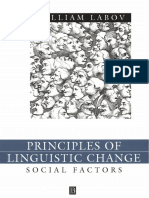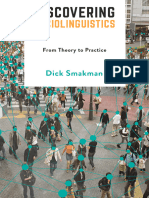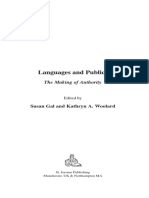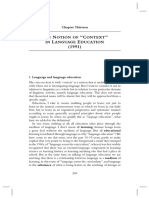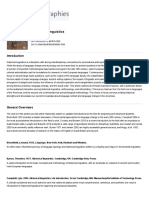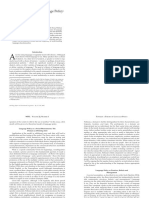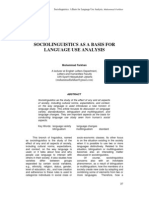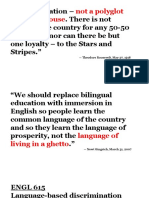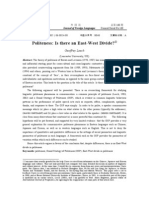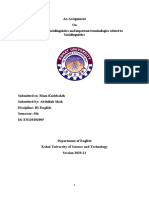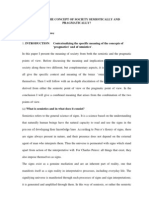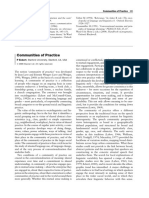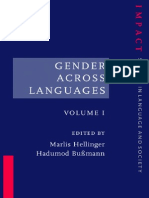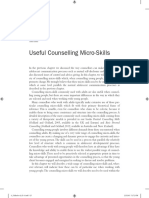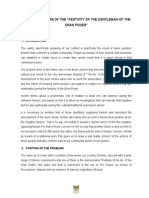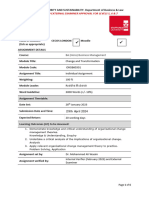Gumprez - Studying Language, Culture and Society - Sociolinguistics or Linguistic Anthropology
Uploaded by
Idc NorthEastGumprez - Studying Language, Culture and Society - Sociolinguistics or Linguistic Anthropology
Uploaded by
Idc NorthEastJournal of Sociolinguistics 12/4, 2008: 532545
Studying language, culture, and society: Sociolinguistics or linguistic anthropology?1
John J. Gumperz and Jenny Cook-Gumperz
University of California, Berkeley and University of California, Santa Barbara
INTRODUCTION
As the papers in this issue show, the study of language, culture, and society has, and always will have, multiple disciplinary roots. In this commentary, we argue that what we may now regard as two traditions, sociolinguistics and linguistic anthropology, are in fact historically interrelated approaches. This raises the question as to whether we should really draw a distinction between the two at all. We begin by considering why sociolinguistics, as a field of enquiry, came to be seen as separate from the broader fields of anthropological linguistics and formal linguistics. As Dell Hymes (1972: 35) comments in Directions in Sociolinguistics (Gumperz and Hymes 1972), to claim that sociolinguistics is a distinct field is to suggest that there are both problems and types of linguistic data that have not been studied before. Hymess statement, published at the beginning of the 1970s, argues that staking out a newly designated disciplinary emphasis does not mean that linguistics is theoretically lacking, but rather that there are problem areas and sets of issues that previous methods of analysis overlooked. While linguistic anthropology can trace its origins back nearly a century, owing its pedigree to the much earlier anthropological linguistics and fieldwork traditions, sociolinguistics can be seen as a recent development with a relatively short history and what is more, one that is a lived history for many of us still working in the field, with all the individual variations of emphasis that this implies. Let us therefore start with a personal account, originally presented at the 2006 Sociolinguistics Symposium meeting, where most of the papers in this special issue were first presented, to place some of the intellectual issues in context. We then go on to unravel the strands that influenced the development of sociolinguistics and to explore the long-term history of the relationship between sociolinguistics and what we now call linguistic anthropology.
C The authors 2008 Journal compilation C Blackwell Publishing Ltd. 2008 9600 Garsington Road, Oxford OX4 2DQ, UK, and 350 Main Street, Malden MA 02148, USA
LANGUAGE, CULTURE, AND SOCIETY
533
JOHN GUMPERZ: A PERSONAL ACCOUNT
My Ph.D. degree was in Germanic linguistics, but my graduate training included anthropological eldwork experience. Following the traditions of dialectology then prevalent in some Germanic linguistics departments, my dissertation dealt with the dialect of a community made up for the most part by descendants of nineteenth-century German immigrants to rural Michigan. Rather than concentrating on the isolation of dialect differences as such, however, I relied on anthropological eldwork techniques of participant-observation, informal conversations with local residents, and in-depth interviewing. These methods allowed me to determine the ways in which the then-current networks of interpersonal relationships overrode the patterning of linguistic variants that I would have expected if I had relied on dialect histories alone. My ndings showed that a new set of variants had been constructed over the hundred or so years of coresidence, which reected religious afliation and friendship patterns in the new homeland rather than conditions in the country of origin. My rst professional position was as a postdoctoral fellow in the newly established division of modern languages at Cornell University, with a faculty of what we would now call functional linguists concerned with structuralist theory and language pedagogy. Theoretical linguistics in those pre-Chomskyan times was still largely concerned with language description and structural grammar within university settings. Cornell had a Ford Foundation grant to undertake comparative area research combining eld-based linguistics with anthropology, sociology, political science, and economics. The thrust of this work was interdisciplinary development studies, and while from todays perspective this exercise might be questioned as Anglocentric hegemony, for Cornells linguists the project served to bring us out of the university into close daily contact with anthropologists and others working on social problems in the eld and applying our knowledge to the solution of real-life issues. My eldwork as a member of the Cornell University research team focused on North Indian villagers and the regional dialect of Hindi they used among themselves. I found myself taking an approach quite similar to that of my dissertation eldwork, combining structural analysis with survey data. Apart from that project, I also served as a faculty member in the newly established Linguistic Institute of South Asia at Deccan College in Pune, India. The Institute was nanced by a grant from the Rockefeller Foundation for the training of young South Asian linguists in modern linguistics. My faculty colleagues in Pune included many major Indian linguists who were familiar with their own traditions both from the deep historical roots of language study in India, grounded in Paninis Sanskrit
C The authors 2008 Journal compilation C Blackwell Publishing Ltd. 2008
534
GUMPERZ AND COOK-GUMPERZ
grammars, and the more recent British functional linguistics of J. R. Firth at the School of Oriental and African Studies at the University of London. For me this meant an exposure to new ways of looking at language outside of the American tradition and outside of the usual academic disciplinary divisions to focus instead on a joint eld-based enterprise. Research emerging from that collaboration was published as a special issue of the International Journal of American Linguistics titled Linguistic Diversity in South Asia (Ferguson and Gumperz 1960), with articles by scholars associated with the Deccan College Institute. William Labov (personal communication) was the rst to recognize the signicance of the Indian research for sociolinguistics when he commented that the special issue was the rst set of studies that centered on sociolinguistic issues. The more immediate U.S. contribution of this work to the development of sociolinguistics was in bringing together interdisciplinary groups of scholars studying related issues of socioeconomic development, each from their own disciplinary perspective. This work soon received national attention, rst by the Association for Asian Studies, which set up a committee on South Asian languages in the 1950s, and later by the Social Science Research Council. In the 1960s the latter organized the Committee on Sociolinguistics with a membership drawn largely from the earlier AAS committee, thus building up a new disciplinary focus out of an overlapping set of academic interests and friendship groupings (Murray 1998). It was here that sociolinguistics, under that name, began its (inter)disciplinary life.
UNRAVELLING THE STRANDS
This account shows that the strands of intellectual influence that underlie the development of early sociolinguistics were intertwined from the very beginning; despite apparent academic divisions, sociolinguistic and anthropological research were closely related. We develop this point by considering three points of disciplinary boundary crossing in early research on language, culture, and society:
the relationship between dialectology and sociolinguistics; the development of the ethnography of communication from anthropological linguistics; and the interaction of sociolinguistics with sociology.
Despite their differences, these areas of research shared a theoretical view of the local community as the site of language use and a methodological commitment to using fieldwork as the best way to obtain information about such language use.
Journal compilation
C C The authors 2008 Blackwell Publishing Ltd. 2008
LANGUAGE, CULTURE, AND SOCIETY
535
Dialectologys contribution to sociolinguistics
In the years after the publication of William Labovs (1966) The Social Stratification of English in New York City, which integrates the quantitative techniques of large-scale sociological surveys into dialectological analysis, variationist sociolinguistics gradually emerged as a major force in shaping U. S. sociolinguistic research. Despite some criticisms of gender bias and of theoretical inadequacies affecting the early work (e. g. Cameron 1992), a closer look at the dialectological inheritance of sociolinguistics shows that many dialectologists paid close attention to the empirical patterning of everyday talk. In doing so, they relied on field-based methodologies that allowed them to examine the linguistic contours of local communities. This fieldwork tradition remains an important legacy of dialectology to contemporary sociolinguistics. Developing out of nineteenth-century concerns with the emerging sense of nationhood throughout Europe and the role of local traditions in establishing communities, European dialectology focused on the borders and differentiations between communities, regions, and populations. Through field research, this work sought to document the origins of dialects and therefore, by extension, the historical validity of local communities (e. g. Gauchat 1905). Using similar methods, social dialectology in the first half of the twentieth century went further in establishing patterns of sound change that could document population shifts, and thus changes in language practices. For example, Uriel Weinreichs (1953) research, relying on his knowledge of Swiss dialectology, turned away from purely descriptive approaches to focus on the effects of bilingual and multilingual contact on the structure of constituent languages. Labovs classic early work in Marthas Vineyard (1963) as well as his initial New York City research (1966) were greatly influenced by his studies with Weinreich. He was able to incorporate some of the insights of this fieldwork tradition into his notion of style shifting in everyday talk and his development of a linguistically comprehensive basis for statistical analysis. As Penelope Eckert comments, Labov makes it clear that local identity is not simply defined spatially or in a socially abstract sense but in the interaction between place and the human life that unfolds there (2000: 22). In other words, Eckert, in reviewing Labovs intellectual contribution, argues that the early tradition of detailed work with local communities and networks was essential. Moreover, as Eckerts own contribution to this special issue demonstrates, this concern with community-based research continues to foster theoretical advances in contemporary variationist sociolinguistics. In her article, she provides multiple illustrations of how the patterned indexical values of linguistic variables can only be understood from the perspective of local communities. This insight owes a debt to the tradition of fieldwork from dialectology.
C The authors 2008 Journal compilation C Blackwell Publishing Ltd. 2008
536
GUMPERZ AND COOK-GUMPERZ
From anthropological linguistics to the ethnography of communication
While the European dialectological tradition established fieldwork as an important sociolinguistic methodology as early as the nineteenth century, other disciplines also contributed to this approach. Throughout the twentieth century, the United States maintained an area of linguistic study that was motivated by anthropological concerns with cultural difference and required extensive fieldbased studies in the tradition of Boas, Sapir, and Kroeber. It is as an heir to this U. S. tradition of field-based studies of language, culture, and society that the ethnography of communication was developed. Until this time, structural linguists had worked in two areas: the grammar of hitherto unwritten or undocumented languages such as American Indian and African languages, and issues of translation into little-known languages for missionary purposes, such as the studies of Kenneth Pike (1971 [1947]) and Eugene Nida (1975), among others. Hymess initial work on the interpretive analysis of Native American myth used his concept of ethnography of speaking as an analytic construct (cf. Hymes 1981), which was later extended to a broader notion of an ethnography of communication. Building on his and others writings beginning in the 1960s (Gumperz and Hymes 1964, 1972; Hymes 1964; Gumperz 1971), this new perspective focused on how language functioned in ethnographically documented speech events, rather than on relations between community-wide cultural norms and linguistic structures abstracted from talk. The ethnography of communication provided the insight that culture is essentially a communicative phenomenon, constituted through talk. Thus anthropologists can study how culture works by observing or participating in a range of culturally distinct speech events. The ethnography of communication laid out an initial program of comparative research on language use that combined ethnographic fieldwork with linguistic analysis. Roman Jakobsons (1960) notion of speech event was adopted as an intermediate level of analysis that provides access to the interpretive process motivating participants actions. Events are taken to be units of analysis in terms of which interpretive practices can be examined in detail. At the same time, events are also valorized entities that frequently enter into public-sphere discussions, such as commentary about the performances in speech making and political rhetoric (e. g. Bauman and Sherzer 1974; Duranti 1994).The move from communities to events as the principal basis of analysis thus shifts the focus to actual talk and performance. The early writings in the ethnography of communication stimulated a great deal of comparative ethnographic research in various parts of the world on the relevant underlying cultural assumptions and structures of speech events, such as who could participate, what topics could be discussed, and what social norms governed participation. Examples of speech events typically described in the literature of the time are ritual performances, ceremonies, and magical
C The authors 2008 Blackwell Publishing Ltd. 2008
Journal compilation
LANGUAGE, CULTURE, AND SOCIETY
537
rites such as are found in small, traditional, largely face-to-face societies, as well as urban minority speech events and routines (Bauman and Sherzer 1974). Later on, as more empirical data became available, work began to focus on the in-depth interpretive examination of the discourse that constitutes the speech event. The basic insight here is that although research must be rooted in fieldwork in local communities, traditional analysts community-level cultural categories do not demonstrably reflect what motivates or accounts for speakers action in everyday encounters. So far, however, most researchers were concerned with specifying what such implicit knowledge is, but not on how it enters into interpretation. Later, sociolinguistics began to address this problem. Initially, linguistic anthropologists relied on ethnographic observations to reveal the cultural assumptions that underlie interpretation; similarly, ethnomethodologists and conversation analysts used close analysis of talk to understand interaction from the point of view of its participants. Somewhat later, another approach emerged that, like conversation analysis, focuses directly on the organization of speech exchanges, but takes a broader view of language as communicating both content and metapragmatic or indexical information about content. This later approach has become known as interactional sociolinguistics (Gumperz 1982, 2001). In this special issue, the analyses by Mary Bucholtz and Kira Hall and by Jack Sidnell build on these traditions of scholarship in different ways by examining how the social actions accomplished through linguistic interaction - which may range as widely as the negotiation of ethnoracial labels, the interactional manifestation of language ideologies, and patterns of repair are based on local interpretive repertoires.
The sociological roots of sociolinguistics in an era of social reconstruction
Finally, there is a third strand to early sociolinguistics that, while still focused on communities and their language use, raised different intellectual issues from those surveyed above. This strand emerged from social problems that developed in the rapid societal changes following World War II. As Tony Judt (2005) points out in his monumental study Postwar: A History of Europe since 1945, the twin tensions of the forty years that followed the Second World War revolved around two main concerns: the need to reconstruct and strengthen a physically damaged society and the need to bring about social change in order to combat a competing ideology of social values. Apart from the German population movements, the initial effort of post-war rebuilding only slowly led to changes in the United Kingdom and Europe. However in the United States, the population movement and economic recovery brought about by World War II gave a greater sense of urgency to the need to understand the changing American urban scene. Many sociological studies in this post-war period focused on problemdriven issues such as the revitalization of communities as a consequence of migration to the industrialized regions; achievement of greater equity through
C The authors 2008 Journal compilation C Blackwell Publishing Ltd. 2008
538
GUMPERZ AND COOK-GUMPERZ
educational access as well as an emphasis on the transmission of cultural values across generations through childrens socialization; and awareness of the dangers of totalitarian regimes and how these could be combated through understanding the workings of political rhetoric. It was these issues that gave early sociolinguistics much of its agenda. The linguistic dimensions of such questions were widely pursued by linguists in the United States; in Britain, they were explored primarily in the work of Basil Bernstein, who alone among sociologists recognized the important role of language in cultural transmission, and thus in the reproduction of social ordering and its class divisions (Bernstein 1972). These developments suggest that in response to the question we posed in the beginning, it may be said that sociolinguistics became separated from anthropology not because it lacked a social theory but because of its early engagement with specific problems of Western industrialized societies at a time when anthropologists still tended to focus their concerns on small-scale groups in non-Western societies. Sociolinguistics took over existing sociological theories in order to apply linguistic analyses to solve contemporary societal problems, such as those of increasing equity and access to U. S. education (Cazden, John and Hymes 1972). While the methods of sociolinguistics were innovative, the socialtheoretical assumptions of sociology went largely unchallenged in sociolinguistic work that took established social theories and their categorizations as a given. In this issue, Monica Heller explores this question in her critique of the use of received sociological categories and concepts within sociolinguistics (see also Woolard 1985). Despite this divergence in approaches and goals, the multiple strands of sociolinguistics remained interwoven, as seen in several of the collections that were published at this time (Fishman 1970; Giglioli 1972; Gumperz and Hymes 1972; Pride and Holmes 1972). The history of sociolinguistics is therefore one characterized by ongoing cross-disciplinary interaction and influence. Having built on our own perspective to explore the methodological and theoretical issues that mark the past several decades of research in the field, we now consider new developments in sociolinguistics and its relationship to linguistic anthropology.
THE REALIGNMENT OF SOCIOLINGUISTICS AND LINGUISTIC ANTHROPOLOGY
The emerging agendas of contemporary sociolinguistics show a shift towards a new linguistic anthropology, a shift illustrated by the papers in this special issue. It took new reflexive social theorizing in anthropology and sociology as well as a change of emphasis in the study of language and culture to bring sociolinguistics and linguistic anthropology back into alignment. The making of recent linguistic anthropology marks a turn away from taking the community as a given bounded unit toward a more constructivist approach. At the same time,
Journal compilation
C C The authors 2008 Blackwell Publishing Ltd. 2008
LANGUAGE, CULTURE, AND SOCIETY
539
linguistic anthropology has engaged with the critical theory that has helped reshape sociology and its involvement with contemporary societal and political issues. From the wide range of these new studies, we briefly mention two themes: the emphasis on identity rather than community as the focus of sociolinguistic analysis and the concern with the political dimension of language in social life.
From the sociology of groups and communities to individuals and identities
Within the new approach to language, culture, and society, both macrosocietal analysis as found in early sociological studies of language and linguistic geography as found in dialectology give way to discourse analysis and interactional analysis. These methods allow researchers to uncover speakers mechanisms for coping with a changing social field. Contemporary societies are increasingly shaped by the mediation of bureaucratic institutions, which affect many areas of daily life and create their own communicative requirements. The increased mobility and diversity of urban life requires more interpersonal negotiation and verbal persuasion; however, the primary issue is not intercultural communication between groups but the identities and style shifting of individuals. In contemporary societies, individuals are seen as separate entities, responsible for their own demeanor, and are no longer protected (or limited) by ascription to a single community-defined category. Given this situation, we now recognize that identity involves the need for continuous validation of the self as a bureaucratically sanctioned entity as well as the ongoing reinvention of the self as a person. Bureaucracy presents specific challenges for individuals in this regard. On the one hand, individuals need to construct coherence through explanations about their own fit or lack of fit to the expected categories. At the same time, they must present a social self that in any single context seems continuous with a history that either precedes or extends beyond the present. On the other hand, late modern societies provide many possibilities for individual change and for the progressive development of the self. In the risk society that characterizes contemporary life, individuals recognize their positions within a number of overlapping social arenas, positions that are both under frequent threat and yet subject to ongoing possibilities for reinvention (Beck, Giddens and Lash 1994). There are risks in change and, in late modern society, also new obligations to make the self a socially acceptable and attractive being as seen in the new growth industry of self-awareness. As Giddens (1991: 209) puts it, new lifestyle movements in late-modern society represent an era beyond the emancipation from want and from hierarchical domination into a politics of choice. Life politics is centered on lifestyle choices and issues of self-actualization from which political consequences flow. From our own perspective, as we have argued elsewhere (Gumperz and Cook-Gumperz 2007), these are also sociolinguistic choices. Moreover, as papers in this special issue show, such choices are not
C The authors 2008 Journal compilation C Blackwell Publishing Ltd. 2008
540
GUMPERZ AND COOK-GUMPERZ
between a finite set of options or variables. Speech styles, as Irvine (2001) points out, have some of the characteristics of clothing styles in that they can be put on to suit an occasion and a situation. However, speech styles also gain durability as they come to index an identity: though open to frequent revision they remain part of an individuals self-presentation. To quote Giddens again:
in the post-traditional order of modernity and against the backdrop of new forms of mediated experience self identity becomes a reflexively organized endeavor. The reflexive product of the self which consists in the sustaining of coherent, yet continuously revised biographical narrative takes place in the context of multiple choices as filtered through abstract systems . . . . The more tradition looses its hold, and the more daily life is reconstituted in terms of the dialectical interplay of the local and global the more individuals are forced to negotiate lifestyle choices among a diversity of options. (1991: 5)
From this perspective, speech styles become aspects of the social in which ways of talking can represent an individuals self-presentation (Gumperz and CookGumperz 2007). Stemming from such insights, the analysis of speech styles has recently again become central to sociolinguistic investigation (Eckert and Rickford 2001). This issue first arose in the post-war era when sociolinguists became attuned to the role of social-class hierarchies in shaping linguistic prestige and power (Labov 1972), but in the current context, style is viewed not as a sign of structural constraint on the speaker but as a resource for self-positioning.
Postcolonial experiences: Language mobilization, politics, and conicts
The threads from which sociolinguistics was woven were not completely created by the Anglo-American and European experience of the hot and cold wars; they were also motivated by earlier concerns with what constitutes a society and a language in the first place. This question has returned in the present day as language enters into new sociopolitical processes of postcolonialism and globalization. In the 1960s and 1970s sociolinguists, faced with the growing diversity of ethnic communities within a class-stratified urban society, saw their task to be to describe a linguistic situation in terms of a collection of speech varieties, of which the most prestigious was the standard variety. More recently, however, sociolinguists have questioned the descriptive validity of categorizing speech varieties into languages and dialects as they were then recognized. James Milroy (2000: 11) raises an issue that is becoming important received knowledge for sociolinguists in the postcolonial age: standard varieties appear as idealizations . . . [that] do not conform exactly to the usage of any particular speaker. Moreover, issues of what constitutes a standard can now be seen to be repeating the ideological misperceptions of the nineteenth century in a new
C The authors 2008 Blackwell Publishing Ltd. 2008
Journal compilation
LANGUAGE, CULTURE, AND SOCIETY
541
guise. Susan Gal and Judith Irvine (2000) make this point in commenting on the nineteenth-century linguistic descriptions that determined language boundaries in West Africa and Central Europe. They argue that linguistic ideology, not language practice as such, was the major factor in the original descriptions by which the colonial administrators and European linguists understood regional distinctions:
Each language . . . was represented in an impoverished way to differentiate it from the other and to accord with an ideology about its essence. At the same time, regional varieties that seemed to overlap were ignored. . . . The same notions of language purity that led nineteenth-century linguists to ignore mixed varieties, multilingualism, and expressions they could attribute to linguistic borrowing also discouraged research on African regional dialectology. Once a variety had been declared to belong to the same language as another already-described variety, there was no reason to investigate it, unless its speakers stubbornly refused to speak anything else. (Gal and Irvine 2000: 5657)
In short, once the ideological principle emerged that a standard language was spoken by a people living and speaking within a territorial area which was viewed as a single nation this principle became entrenched within Western (colonial) language history. And the story is one that was repeated around the global from Africa to the South Asian and East Asian subcontinents, and that continues to be an important factor in language policies and politics. Early sociolinguistic researchers addressed the question of linguistic diversity in a rather different but no less problematic way. As we noted above, these scholars had advanced the notion of linguistic repertoires to explain the pervasive plurilingualism they discovered in their empirical research and to account for the totality of verbal resources available to members of speech communities (Gumperz 1971). Repertoires are usually defined as systems of functionally differentiated, partially overlapping speech varieties, such as social and geographical dialects, registers and styles, and trade and professional languages, each with its own grammatical characteristics; the assumption was that speakers choose among these. However, as Gal and Irvine suggest, the very concept of speech community reflects the 1960s sociological thinking that highlighted a view of social order as integrative. The notion of repertoire simply subdivided a larger bounded unit into smaller ones, without challenging the thinking on which this division rests; speech communities continued to be seen as bounded, internally integrated units. In this way, any difference could be treated as positive and nondivisive. All of this rethinking of traditional sociolinguistic concepts and assumptions has led to a radical change in how to understand the internal diversification of todays nation-states and the competing forces in urban environments. Social, political, and technological changes have resulted in a new alignment between sociolinguists and linguistic anthropologists exploring language ideologies.
C The authors 2008 Journal compilation C Blackwell Publishing Ltd. 2008
542
GUMPERZ AND COOK-GUMPERZ
Kathryn Woolards article in this issue, for example, argues for the necessity of using the linguistic-anthropological concept of language ideologies to account for fundamental processes of language change within variationist sociolinguistics. Such connections and there are many others in the papers in this special issue point to the value of collaborative work in shedding light on the complex phenomena of late modern societies.
CONCLUSION
In this commentary, we have argued that the fields of linguistic anthropology and sociolinguistics have come together again thanks to a new critical awareness of the possibilities that research on language and culture can offer for contemporary issues, much as in early sociolinguistics a new approach grew out of an urgency necessitated by social changes. Such a critical stance is especially appropriate in reconsidering the new issues of language politics and postcolonial language, now seen as part of a changing urban sense of personal identity and belonging. However, this viewpoint does not always assure an alignment between researchers, their publics, and governmental policymakers and funding sources. In todays political and administrative climate, governmental and private funding and channeling of research interests is more likely to be directed to immediate solutions of pressing problems, not to the shaping or directing of long-term intellectual agendas. The concerned public now forms a vocal and critical part of any research on language issues. Researchers are no longer the experts courted by non-specialist outsiders but can easily be seen as just another interested party. Issues like these are vividly illustrated by Charles Briggs and Clara MantiniBriggs (2000) in their study of the cholera epidemic in Venezuela and the repercussions of the governments response for local populations, from which both political and sociolinguistic insights can be gained. Similarly, Diana Eades (1992) shows how a sociolinguistic understanding of communicative practices makes aboriginal populations both more aware of how to make their political case and yet more open to manipulation and persuasion by others. These ethical dilemmas arise as sociolinguists begin to ask questions about whose language and whose concerns are really being addressed in sociolinguistic research. Nor are these issues easy to resolve, as Jan Blommaert and Jef Verschueren (1998) point out, noting that the researcher, by reflexively becoming part of the research, is also implicated in any debates and disagreements that follow. In other words, sociolinguists and linguistic anthropologists who seek to engage in the complex politics of language in social life, willing or not, are likely to find themselves either in the role of public intellectuals or public scapegoats. Nevertheless, these positions of intellectual responsibility are an important consequence of the theoretical shift that has brought sociolinguistics and linguistic anthropology back into alignment. As the fields continue to develop in tandem, their continued confrontation of such challenges is an
Journal compilation
C C The authors 2008 Blackwell Publishing Ltd. 2008
LANGUAGE, CULTURE, AND SOCIETY
543
indication of their ongoing engagement in important real-world issues of language, culture, and society and the role of the researcher in addressing them.
NOTE
1. Our thanks to Mary Bucholtz for helpful editorial suggestions.
REFERENCES
Bauman, Richard and Joel Sherzer (eds.). 1974. Explorations in the Ethnography of Speaking. Cambridge, U.K./New York: Cambridge University Press. Beck, Ulrich, Anthony Giddens and Scott Lash. 1994. Reflexive Modernization: Politics, Traditions and Aesthetics in the Modern Social Order. Stanford, California: Stanford University Press. Bernstein, Basil. 1972. A sociolinguistic approach to socialization with some reference to educability. In John J. Gumperz and Dell Hymes (eds.) Directions in Sociolinguistics. New York: Holt Rinehart and Winston. 465497. Blommaert, Jan and Jef Verschueren. 1998. Debating Diversity: Analysing the Discourse of Tolerance. London/New York: Routledge. Briggs, Charles and Clara Mantini-Briggs. 2000. Stories in the Time of Cholera. Berkeley, California/London: University of California Press. Cameron, Deborah. 1992. Feminism and Linguistic Theory. New York: St. Martins Press. Cazden, Courtney, Vera John and Dell Hymes. 1972. Functions of Language in the Classroom. New York: Teachers College Press. Duranti, Alessandro. 1994. From Grammar to Politics. Berkeley, California: University of California Press. Eades, Diana. 1992. Aboriginal English and the Law. Brisbane, Australia: Queensland Law Society. Eckert, Penelope. 2000. Linguistic Variation as Social Practice. Oxford, U.K./Malden, Massachusetts: Blackwell. Eckert, Penelope and John R. Rickford (eds.). 2001. Style and Sociolinguistic Variation. Cambridge, U.K.: Cambridge University Press. Ferguson, Charles and John J. Gumperz. 1960. Linguistic diversity: Studies in regional, social and functional variation. Special issue of the International Journal of American Linguistics 26(3). Fishman, Joshua. 1970. Sociolinguistics: A Brief Introduction. Rowley, Massachusetts: Newbury House. Gal, Susan and Judith T. Irvine. 2000. Language ideology and linguistic differentiation. In Paul V. Kroskrity (ed.) Regimes of Language: Ideologies, Polities and Identities. Santa Fe, New Mexico: School for American Research Press. 3583. Gauchat, Louis. 1905. Lunite phonetique dans le patois dune commune. In Festschrift Heinrich Morf: Aus Romanischen Sprachen und Literaturen. Halle, Germany: Max Niemeyer. 175232.
C The authors 2008 Journal compilation C Blackwell Publishing Ltd. 2008
544
GUMPERZ AND COOK-GUMPERZ
Giddens, Anthony. 1991. Modernity and Self Identity: Self and Society in the Late Modern Age. Stanford, California: Stanford University Press. Giglioli, Pier Paolo (ed.). 1972. Language and Social Context: Selected Readings. Harmondsworth, U.K.: Penguin. Gumperz, John J. 1971. Language and Social Groups. Stanford, California: Stanford University Press. Gumperz, John J. 1982. Discourse Strategies. Cambridge, U.K./New York: Cambridge University Press. Gumperz, John J. 2001. Interactional sociolinguistics: A personal perspective. In Deborah Schiffrin, Deborah Tannen and Heidi Hamilton (eds.) The Handbook of Discourse Analysis. Malden, Massachusetts: Blackwell. 215228. Gumperz, John J. and Jenny Cook-Gumperz. 2007. Style and identity in interactional sociolinguistics. In Peter Auer (ed.) Style and Social Identities: Alternative Approaches to Linguistic Heterogeneity. Berlin, Germany: Mouton de Gruyter. 477498. Gumperz, John J. and Dell Hymes (eds.). 1964. The ethnography of communication. Special issue of American Anthropologist 66(6), part 2. Gumperz, John J. and Dell H. Hymes (eds.). 1972. Directions in Sociolinguistics: The Ethnography of Communication. New York: Holt, Rinehart and Winston. Hymes, Dell H. 1964. Toward ethnographies of communication: Analysis of communicative events. American Anthropologist 66(6): 1225. Hymes, Dell H. 1972. Models of the interaction of language and social life. In John J. Gumperz and Dell H. Hymes (eds.) Directions in Sociolinguistics: The Ethnography of Communication. New York: Holt, Rinehart and Winston. 3571. Hymes, Dell H. 1981. In Vain I Tried to Tell You: Essays in Native American Ethnopoetics. Philadelphia, Pennsylvania: University of Pennsylvania Press. Irvine, Judith. 2001. Style as distinctiveness: The culture and ideology of linguistic differentiation. In Penelope Eckert and John R. Rickford (eds.) Style and Sociolinguistic Variation. Cambridge, U.K.: Cambridge University Press. 2143. Jakobson, Roman. 1960. Concluding statement: Linguistics and poetics. In Thomas Sebeok (ed.) Style in Language. Cambridge, Massachusetts: MIT Press. 350377. Judt, Tony. 2005. Postwar: A History of Europe since 1945. London/New York: Penguin. Labov, William. 1963. The social motivation of a sound change. Word 19: 273309. Labov, William. 1966. The Social Stratification of English in New York City. Washington, DC: Center for Applied Linguistics. Labov, William. 1972. Sociolinguistic Patterns. Philadelphia, Pennsylvania: University of Pennsylvania Press. Milroy, James. 2000. Historical description and the ideology of standard language. In Laura Wright (ed.) The Development of Standard English, 13001800: Theories, Descriptions, Conflicts. Cambridge, U.K.: Cambridge University Press. 1128. Murray, Stephen O. 1998. American Sociolinguistics: Theorists and Theory Groups. Amsterdam, The Netherlands/Philadelphia, Pennsylvania: John Benjamins. Nida, Eugene. 1975. Language Structure and Translation: Essays of Eugene Nida. Stanford, California: Stanford University Press. Pike, Kenneth. 1971 [1947]. Phonemics: A Technique for Reducing Language to Writing. Ann Arbor, Michigan: University of Michigan Press. Pride, John and Janet Holmes. 1972. Sociolinguistics: Selected Readings. Harmondsworth, U.K.: Penguin. Weinreich, Uriel. 1953. Languages in Contact: Findings and Problems. The Hague, The Netherlands: Mouton.
Journal compilation
C C The authors 2008 Blackwell Publishing Ltd. 2008
LANGUAGE, CULTURE, AND SOCIETY
545
Woolard, Kathryn. 1985. Language variation and cultural hegemony: Toward an intergration of sociolinguistics and social theory. American Ethnologist 12: 738 748.
Address correspondence to: John J. Gumperz Department of Anthropology 232 Kroeber Hall University of California, Berkeley Berkeley, CA 94720-3710 U.S.A. [email protected]
C The authors 2008 Journal compilation C Blackwell Publishing Ltd. 2008
You might also like
- (Language in Society 29) William Labov - Principles of Linguistic Change, Volume 2 - Social Factors-Blackwell (2001)No ratings yet(Language in Society 29) William Labov - Principles of Linguistic Change, Volume 2 - Social Factors-Blackwell (2001)585 pages
- Discovering Sociolinguistics From Theory To PracticeNo ratings yetDiscovering Sociolinguistics From Theory To Practice309 pages
- GAL, Susan WOOLARD, Kathryn A. Languages and Publics - The Making of Authority (2001, ST Jerome Publishing) PDFNo ratings yetGAL, Susan WOOLARD, Kathryn A. Languages and Publics - The Making of Authority (2001, ST Jerome Publishing) PDF191 pages
- Milroy (1985) - Linguistic Change, Social Network and Speaker InnovationNo ratings yetMilroy (1985) - Linguistic Change, Social Network and Speaker Innovation47 pages
- COUPLAND, N. Language, Situation, and The Relational Self - Theorizing Dialect-Style in SociolinguisticsNo ratings yetCOUPLAND, N. Language, Situation, and The Relational Self - Theorizing Dialect-Style in Sociolinguistics26 pages
- Halliday 1991 Context in Language Education Yc7ta4100% (1)Halliday 1991 Context in Language Education Yc7ta422 pages
- Language Style As Audience Design - Allan Bell - 1984100% (1)Language Style As Audience Design - Allan Bell - 198459 pages
- Liv - Schieffelin, Woolard, Kroskrity (1998) - Language Ideologies Practice and Theory - Oxford Studies in Anthropological Linguistics, 16)100% (3)Liv - Schieffelin, Woolard, Kroskrity (1998) - Language Ideologies Practice and Theory - Oxford Studies in Anthropological Linguistics, 16)353 pages
- Ethnography, Superdiversity and Linguistic Landscapes: Chronicles of ComplexityFrom EverandEthnography, Superdiversity and Linguistic Landscapes: Chronicles of ComplexityNo ratings yet
- Kroskrity2015 LanguageIdeologies EmergenceElaborationandApplicationNo ratings yetKroskrity2015 LanguageIdeologies EmergenceElaborationandApplication15 pages
- The Dynamics of Language and Inequality in Education: Social and Symbolic Boundaries in the Global SouthFrom EverandThe Dynamics of Language and Inequality in Education: Social and Symbolic Boundaries in the Global SouthJoel Austin WindleNo ratings yet
- Bilingual Brokers: Race, Literature, and Language as Human CapitalFrom EverandBilingual Brokers: Race, Literature, and Language as Human CapitalNo ratings yet
- English as a Local Language: Post-colonial Identities and Multilingual PracticesFrom EverandEnglish as a Local Language: Post-colonial Identities and Multilingual PracticesNo ratings yet
- Dialogues with Ethnography: Notes on Classics, and How I Read ThemFrom EverandDialogues with Ethnography: Notes on Classics, and How I Read ThemNo ratings yet
- Discourse analysis applied to english language teaching in colombian contexts: theory and methodsFrom EverandDiscourse analysis applied to english language teaching in colombian contexts: theory and methodsNo ratings yet
- Language Planning and Language Ecology: Towards A Theoretical Integration100% (3)Language Planning and Language Ecology: Towards A Theoretical Integration19 pages
- Eckert Rickford (Eds.) (2001) Style Anda Sociolinguistic VariationNo ratings yetEckert Rickford (Eds.) (2001) Style Anda Sociolinguistic Variation359 pages
- Towards A Theory of Language Policy: Bernard SpolskyNo ratings yetTowards A Theory of Language Policy: Bernard Spolsky8 pages
- (Ebook) Classroom Discourse: The Language of Teaching and Learning by Courtney Cazden ISBN 9780325003788, 0325003785 2024 scribd download100% (3)(Ebook) Classroom Discourse: The Language of Teaching and Learning by Courtney Cazden ISBN 9780325003788, 0325003785 2024 scribd download72 pages
- Matthiessen - 2011 - Systemic Functional Linguistic Approaches ToCritical Discourse Analysis - For - Delta - CorrectedNo ratings yetMatthiessen - 2011 - Systemic Functional Linguistic Approaches ToCritical Discourse Analysis - For - Delta - Corrected29 pages
- Street - The New Literacy Studies, Guest Editorial100% (1)Street - The New Literacy Studies, Guest Editorial17 pages
- Beaugrande R., Discourse Analysis and Literary Theory 1993No ratings yetBeaugrande R., Discourse Analysis and Literary Theory 199324 pages
- Grossi V Teaching Pragmatic Competence Compliments and100% (1)Grossi V Teaching Pragmatic Competence Compliments and10 pages
- Analyzing Metaphor and Gender in Discourse: Cite This PaperNo ratings yetAnalyzing Metaphor and Gender in Discourse: Cite This Paper24 pages
- Mallinson,_Christine_Data_Collection_in_Sociolinguistics_TaylorNo ratings yetMallinson,_Christine_Data_Collection_in_Sociolinguistics_Taylor348 pages
- 2009 Seidlhofer World English Lingua FrancaNo ratings yet2009 Seidlhofer World English Lingua Franca10 pages
- Sociolinguistics of Narrative (Thornborrow y Coates) PDF100% (1)Sociolinguistics of Narrative (Thornborrow y Coates) PDF307 pages
- Lenore A. Grenoble Lindsay J. Whaley Saving - Languages An Introduction To Language Revitalization100% (1)Lenore A. Grenoble Lindsay J. Whaley Saving - Languages An Introduction To Language Revitalization245 pages
- Contrastive Studies-History and Development100% (1)Contrastive Studies-History and Development17 pages
- Semantic Analysis of English Verbs in Reuters World Tweets: Mustansiriyah University0% (1)Semantic Analysis of English Verbs in Reuters World Tweets: Mustansiriyah University6 pages
- Stancetaking in Discourse: The Stance TriangleNo ratings yetStancetaking in Discourse: The Stance Triangle23 pages
- John Holm-Languages in Contact The Partial Restructuring of Vernaculars (2004) PDF100% (1)John Holm-Languages in Contact The Partial Restructuring of Vernaculars (2004) PDF197 pages
- Alwin Fill Peter Muhlhausler The Ecolinguistics Reader Language Ecology and Environment 2001100% (1)Alwin Fill Peter Muhlhausler The Ecolinguistics Reader Language Ecology and Environment 2001305 pages
- Discourse - Langiage Online - (Whole Book) PDF100% (1)Discourse - Langiage Online - (Whole Book) PDF220 pages
- Hellinger - Busmann - Gender Across Languages 2001100% (4)Hellinger - Busmann - Gender Across Languages 2001344 pages
- Critical Discourse Analysis of TelecommunicationNo ratings yetCritical Discourse Analysis of Telecommunication13 pages
- An Introduction To The Nature and Functions of Language100% (3)An Introduction To The Nature and Functions of Language247 pages
- Inside Out Movie Reflection and EmotionsNo ratings yetInside Out Movie Reflection and Emotions2 pages
- Secondary Lesson Plan: Victorian CurriculumNo ratings yetSecondary Lesson Plan: Victorian Curriculum6 pages
- Group 2 Popcorn Brain Xi Mipa 4 - 20240502 - 200950 - 0000No ratings yetGroup 2 Popcorn Brain Xi Mipa 4 - 20240502 - 200950 - 00007 pages
- Introduction To Montessori Education0001 PDFNo ratings yetIntroduction To Montessori Education0001 PDF5 pages
- Mary Margaret Que - Challenges and OpportunitiesNo ratings yetMary Margaret Que - Challenges and Opportunities40 pages
- Conflict or Consensus - An Investigation of Stakeholder Concerns DuringNo ratings yetConflict or Consensus - An Investigation of Stakeholder Concerns During10 pages
